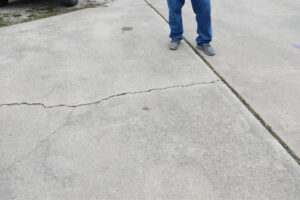See our work on social media:
Maintenance Monday:
When Was Asphalt Paving Invented

At Calvac Paving, we think the history and evolution of paving and construction materials over time is just as interesting and important as using them properly to deliver great, durable results for the projects we work on. For this week’s Maintenance Monday installment, we’re going to take a look at the surprising and fascinating history of asphalt and answer a few questions we get a lot from clients and the general public. You might even learn new facts to stump your friends or help your trivia team crush the competition, courtesy of your friends at Calvac Paving!
When Was Asphalt Invented?
The “active” ingredient in asphalt is tar, also called pitch and technically known as bitumen. It is a naturally occurring petroleum byproduct that is formed from the decomposition of buried plants that were ancient when the dinosaurs rose to ascendancy on the planet. It is often found in pitch lakes and oil sands. It is also created as a byproduct of petroleum distillation, which today is the most popular source of bitumen due to global fossil fuel consumption. One of the most famous natural sources of bitumen is California’s very own La Brea Tar Pits, which also happens to be one of the most notorious and productive Ice Age fossil concentrations in America. This is because water accumulating and floating on the surface of the pits attracted prehistoric animals to drink from it—trapping them in the hot tar and preserving their remains! The earliest known references to the use of bitumen as a building material date all the way back to ancient Mesopotamia. Bitumen was used to waterproof temple roofs, ritual baths, and rainwater collection vessels, basically serving as an ancient precursor to silicone caulking. The Phoenicians used pitch to protect the hulls of their ships from the ravages of saltwater, weather, wind, and waves, which in turn helped rank them among the world’s most skilled and feared navies of the day. There is a school of thought that suggests the formula for the legendary “Greek fire,” which could burn on water and was primarily developed as a counteroffensive measure against the Phoenicians and other seafaring foes, may have incorporated bitumen in some way, though this cannot be factually substantiated since the actual process for producing this fearsome weapon has been lost to the ages. In Egypt, bitumen was employed as an adhesive for the funerary wrappings of royalty to protect both the earthly bodies and the treasures bound within the linen bandages which formed the shroud.
To The Best Of Our Knowledge, Ancient Babylon Has The Best Claim To Fame For The First Use Of Asphalt As A Paving Material, Somewhere Around 625BCE.
From Babylon and Carthage, the idea caught on with both the Greeks and the Romans. In fact, the word “asphalt” derives from a Greek word, “asphaltos,” meaning “secure.” The Romans used this new Babylonian technology to create smoother, more efficient roads to move goods, supplies, and, naturally, military forces throughout the Empire. The first use of asphalt as pavement in modern history appears to date to the 1700s, when an Englishman named John Metcalf began laying roads using asphalt around England. A Scot, Thomas Telforld, took up the idea and brought it to Scotland, where it was later perfected by one John Loudon Macadam. Macadam used a combination of crushed rock and bitumen to create his asphalt roads, giving rise to the names “tarmacadam,” “macadam” and “tarmac,” all names which are still in common use on the Continent, and to a lesser extent in the United States, today.
Asphalt in America
The first recorded asphalt roads in the United States were laid in Newark, New Jersey and on Pennsylvania Avenue in Washington, DC by a Belgian chemist, Edmund DeSmedt, in 1870. This was also the year the first hot mix production operation in the United States began. Curiously, the first patent for asphaltic concrete was not filed until 1871! Another patent in 1900 referenced “bitulithic” concrete, a portmanteau term of “bitumen” and “lithos,” the Greek word for “stone,” which set the foundational template for nearly all asphalt mix designs used in America up to the present day. As early as 1907, the rise of automobiles as a primary transportation method and the increasing demand for gasoline to fuel them had made man-derived asphalt the most popular source of bitumen. In a magnificent twist of ingenuity and synchronicity, the very thing that made cars run also provided the materials on which they could drive!
Asphalt Today
Today, asphalt or asphaltic concrete, as it is technically known, is by far the most popular paving material for everything from parking lots to interstate highways. It is also used in roofing materials such as asphalt shingles. Raw hot mix can also be applied to the surface of a roof, creating a light, strong, waterproof surface. Natural asphalt is rarely used these days, partially because asphalt derived as a byproduct of petroleum production is so plentiful and relatively cheap compared to the expense and effort required to distill asphalt into a usable purified form. Another reason natural asphalt sources go largely untapped is because many of them, like the La Brea Tar Pits, are protected by local, state, and federal laws for their paleontological and cultural value. Fossil plants, animals, insects, and human artifacts from Native American tribes in these areas have all been found, making their ongoing conservation and preservation a major point of interest to nature and environmental groups, Native American tribes, and government agencies alike. Finally, asphalt is one of the most recycled substances on earth. An estimated 89.2 MILLION tons (178.4 billion pounds/81.09 billion kilograms) of asphalt were reclaimed and recycled into new mixes in 2019 in America alone according to the National Asphalt Paving Association. This means that overall, asphalt is very environmentally friendly and is not considered an air pollutant by the EPA, even though the fumes from fresh asphalt can be a little overwhelming if you’re not used to them. So the next time you’re driving down the highway or pulling into your own driveway, you might take a moment and spare a thought for the fact you’re driving on the results of an idea older than recorded history! And of course, for all your concrete and asphalt paving needs, click here to contact Calvac Paving and get the job done right the first time, every time!
Company
Services
Contact us
© 2025 All Rights Reserved.






